

Indo-Aryan languages. Hindustani language. History[edit] Early forms of present day Hindustani emerged from the Middle Indo-Aryan apabhramsha vernaculars of North India in the 7th–13th centuries CE.[16] Amir Khusro, who lived in the 13th century CE during the Delhi Sultanate period in North India, used these forms (which was the lingua franca of the period) in his writings and referred to the language as Hindavi.[16] The Delhi Sultanate, which comprised several Turkic and Persian dynasties that ruled from Delhi, was succeeded by the Mughal Empire in 1526.
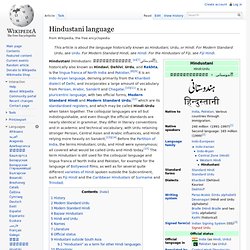
The phrase Zabān-e Urdu-e Mo'alla written in Nasta'liq calligraphy Although the Mughals were of Timurid (Gurkānī) Turko-Mongol descent,[17] they were Persianized, and Persian had gradually become the state language of the Mughal empire after Babur.[18][19][20][21] As an emerging common dialect, Hindustani absorbed large numbers of Persian, Arabic, and Turkic words, and as Mughal conquests grew it spread as a lingua franca across much of northern India. Modern Standard Urdu[edit] Rekhta. Rekhta (Urdu: ریختہ, Hindi: रेख़्ता rextā) was the Hindustani language as its dialectal basis shifted to the Khariboli dialect of Delhi.
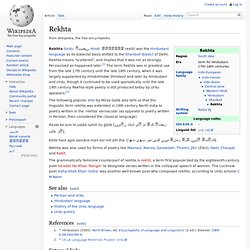
Rekhta means "scattered", and implies that it was not as strongly Persianized as happened later.[1] The term Rekhta was in greatest use from the late 17th century until the late 18th century, when it was largely supplanted by Hindi/Hindwi (Hindavi) and later by Hindustani and Urdu, though it continued to be used sporadically until the late 19th century.
Rekhta-style poetry is still produced today by Urdu speakers.[2] Rexte ke tum hī ustād nahīṅ ho ğālib (ريختہ کے تم ہی استاد نہیں ہو غالب), Kihte haiṅ agle zamāne meṅ koī mīr bhī thā. (کہتے ہیں اگلے زمانے میں کوئی میر بھی تھا). The grammatically feminine counterpart of rekhta is rekhti, a term first popularized by the eighteenth-century poet Sa'adat Yar Khan 'Rangin' to designate verses written in the colloquial speech of women. Hindi. Related languages and dialects[edit] Standard Hindi is mutually intelligible with the other standardised register of Hindustani, Urdu, which is associated with the North Indian Muslim community.
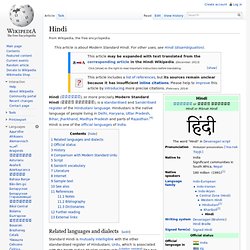
[citation needed] The two standards are nearly identical in structure and grammar. Mutual intelligibility decreases in literary and specialised contexts, which rely on educated vocabulary drawn from different sources; Hindi drawing its specialised vocabulary from Sanskrit, whilst Urdu does so from Persian and Arabic. Urdu. Urdu (/ˈʊərduː/; Urdu: اُردُو ALA-LC: Urdū; IPA: [ˈʊrd̪uː] ( Urdu and Hindi are nearly identical in basic structure and grammar, and at a colloquial level also in vocabulary and phonology.
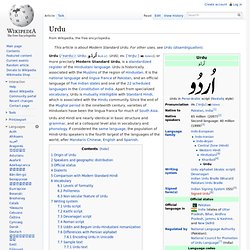
Bengali language. Bengali /bɛŋˈɡɔːli/[4] or Bangla /bɑːŋlɑː/ (বাংলা Bangla [ˈbaŋla] ( )) is the language native to the region of Bengal, which comprises present-day Bangladesh and the Indian states West Bengal, Tripura and southern Assam.
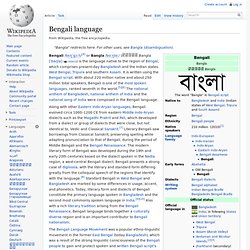
It is written using the Bengali script. With about 220 million native and about 250 million total speakers, Bengali is one of the most spoken languages, ranked seventh in the world.[5][6] The national anthem of Bangladesh, national anthem of India and the national song of India were composed in the Bengali language. History[edit] Like other Eastern Indo-Aryan languages, Bengali arose from eastern Middle Indo-Aryan dialects of Magadhi Prakrit and Pali. Shohid Minar, or the Martyr's monument, in Dhaka, commemorates the struggle for the Bengali language. Punjabi language. Punjabi dialects.
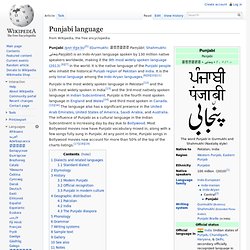
Marathi language. Marathi (/məˈrɑːti/;[7] मराठी Marāṭhī [məˈɾaʈʰi]) is an Indo-Aryan language.
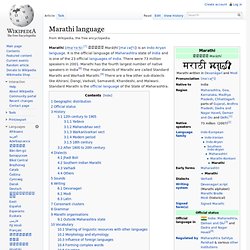
It is the official language of Maharashtra state of India and is one of the 23 official languages of India. There were 73 million speakers in 2001. Marathi has the fourth largest number of native speakers in India[8] The major dialects of Marathi are called Standard Marathi and Warhadi Marathi.[9] There are a few other sub-dialects like Ahirani, Dangi, Vadvali, Samavedi, Khandeshi, and Malwani.
Oriya language. Gujarati language. Gujarati /ɡʊdʒəˈrɑːti/[4] (ગુજરાતી Gujarātī [ɡudʑəraːt̪i]) is an Indo-Aryan language native to the west Indian region of Gujarat.
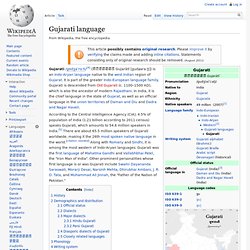
It is part of the greater Indo-European language family. Gujarati is descended from Old Gujarati (c. 1100–1500 AD), which is also the ancestor of modern Rajasthani. In India, it is the chief language in the state of Gujarat, as well as an official language in the union territories of Daman and Diu and Dadra and Nagar Haveli. According to the Central Intelligence Agency (CIA), 4.5% of population of India (1.21 billion according to 2011 census) speaks Gujarati, which amounts to 54.6 million speakers in India.[5] There are about 65.5 million speakers of Gujarati worldwide, making it the 26th most spoken native language in the world. Nepali language. Nepali or Nepalese (नेपाली), is a language in the Indo-Aryan languages.
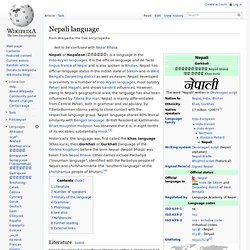
It is the official language and de facto lingua franca of Nepal and is also spoken in Bhutan. Nepali has official language status in the Indian state of Sikkim and in West Bengal's Darjeeling district as well as Assam. Nepali developed in proximity to a number of Indo-Aryan languages, most notably Pahari and Magahi, and shows Sanskrit influences. However, owing to Nepal's geographical area, the language has also been influenced by Tibeto-Burman. Nepali is mainly differentiated from Central Pahari, both in grammar and vocabulary, by Tibeto-Burman idioms owing to close contact with the respective language group.
Saraiki dialect. Saraiki (Shahmukhi: سرائیکی) is the southern dialect of Western Punjabi of the Indo-Aryan (Indic) language family.

An organization namely Saraiki Academy was founded in Multan on 6 April 1962.[3] It is spoken by 17 million people (2007) across the South Punjab, southern Khyber Pakhtunkhwa, and border regions of North Sindh and Eastern Balochistan, with some 20,000 migrants and their descendants in India[1] who migrated as a result of the partition of India, as well as overseas, especially in the Middle East.
Saraiki is also spoken by some Hindus in Afghanistan, though the number there is unknown.[4] Language or dialect[edit] For more information, see Punjabi dialects. Since Sindhi, Punjabi, Urdu and Hindi are spoken in a region that has witnessed significant ethnic and identity conflict, all have been exposed to the dialect-versus-language question. Hindi languages. Sinhala language. Sinhala has its own writing system, the Sinhala alphabet, which is a member of the Brahmic family of scripts, and a descendant of the ancient Indian Brahmi script.
Assamese language. Chittagonian language. Chittagonian (Chittagonian: টগাঁইয়া বুলি Caṭgãia Buli), also "Chatgaya", is an Indo-Aryan language spoken by the people of Chittagong in Bangladesh and in much of the southeast of the country. It is closely related to Bengali–Assamese and is often considered to be a non-standard dialect of Bengali, although it is not inherently intelligible with it.[2] It is estimated (2009) that Chittagonian has 13 million speakers, principally in Bangladesh[3] and the United States. Sindhi language. Sindhi /ˈsɪndi/[3] (سنڌي / सिन्धी /